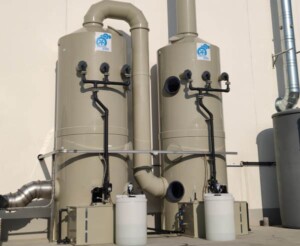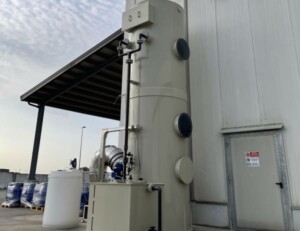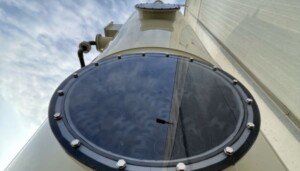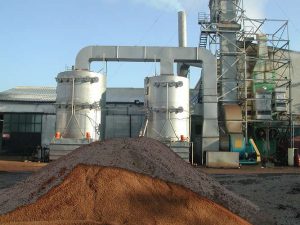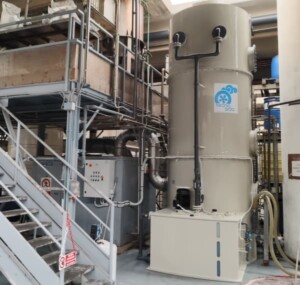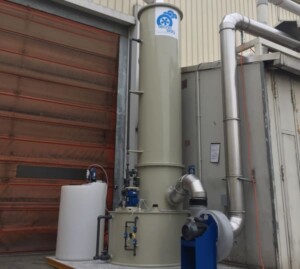Industrial wet scrubber – WETCLEAN
Scrubber for the abatement of VOCs, VICs and industrial dust
What is the industrial wet scrubber WETCLEAN?
The WETCLEAN scrubber, or washing tower, is a wet abatement technology where the pollutants in an airflow are removed thanks to the use of a water-based washing liquid. Wet scrubbers are particularly recommended for the abatement of soluble VOCs (Volatile organic compound), VICs (Volatile Inorganic Compounds) and dust. Below we will explain how they work.
How does a industrial wet scrubber work? Focus on pollutant removal
As we have already seen, washing towers wash the airflow, neutralising the pollutants. To do so, a tank containing the water solution is located at the base of the vertical scrubber. This solution is then pumped into the upper part of the wet scrubber using recirculation pumps and spray nozzles, which spray the liquid inside the tower, reducing the pollutants. The air enters from the lower part of the tower.
This configuration, called countercurrent flow, maximises the mass transfer between the water solution and the airflow, which enters upstream from the lower part of the scrubber.
To ensure the proper treatment of pollutants, the water solution must have suitable pH and Redox. Acid pollutants are treated with basic solutions (such as caustic soda), while basic pollutants are treated with acid solutions (such as sulphuric acid).
Sometimes using oxidising agents (such as hydrogen peroxide) is needed to realize oxidation reactions which further improve the pollutant removal efficiency. If there are metabolic substances (such as ethanol) which facilitate bacterial growth, biocide agents or other oxidizing solutions (sodium hypochlorite, peracetic acid or similar) must be added to reduce the bacterial flora and the potential pathogenic load.
The dosing station is equipped with tanks containing reagents and dosing pumps used to balance the parameter values and ensuring an adequate abatement efficiency.
After having been treated inside the washing tower, the airflow passes through the droplet separator which recovers the residual droplets, avoiding their release into the environment, which would cause the so-called “smoke plume effect”.
The scrubbers for air treatment can be composed of one, two or more stages. The number varies according to the types of pollutants and their concentration. For example, two-stage industrial wet scrubbers can be used when the airflow contains both acid (hydrogen sulphide, mercaptans) and basic pollutants (ammonia, organic nitrogen).
The operating principle of vertical towers is the same used in horizontal scrubbers, with the only difference being the shape. In horizontal scrubbers, there is a cross-flow (water from the top, and air horizontal) instead of a countercurrent airflow. The airflow comes in along the axis of the scrubber, while the liquid is sprayed partly from the top and partly in equicurrent.
Horizontal scrubbers can be designed with one or more abatement stages and they are recommended when the available spaces do not allow vertical development and when compactness is more important than abatement efficiency.
Industrial wet scrubbers: available models
When designing a wet scrubber, it is important to choose its shape and to establish the most convenient model for the customer’s specific needs. Taking into account the range and the type of pollutants, it is possible to choose among the following models of wet collectors (scrubbers):
- Static bed scrubbers: this type of scrubbers contains two or more stages filled with packing material (random or packed) . These are constantly sprayed by spray nozzles and are used to maximise the contact between the water solution and the airflow, facilitating the pollutant abatement. According to the flow temperature and the type of pollutant, it is possible to use filling bodies of different shapes, types, sizes and materials (PP, PVC, PVDF, Teflon PFA, ceramic);
- Floating bed scrubbers: this type of wet scrubber differs from the previous one because it does not contain static filling bodies. It contains light spheres that move when air enters the tower. This wet collectors (scrubbers) are particularly recommended when the airflow contains particulate, because it reduces pollutants and at the same time it keeps filling bodies clean thanks to the constant movement of the spheres.
- Hydro Venturi: it is used for dusts and as a pre-treatment for dirty airflows which are particularly complex to treat. It can be used together with the static bed scrubber
Wet scrubber WETCLEAN: advantages
- it is designed and manufactured according to the customers’ specific needs, taking into account the available spaces, the pollutants to be treated and their concentration;
- it can be manufactured with different materials according to the temperatures and the pollutants to be treated;
- wet collectors (scrubbers) are equipped with an automated reagent management system;
- it is equipped with various inspection manhole, which also allow the replacement of the filling bodies;
- the droplet separator is included;
- low maintenance costs
Industrial wet scrubber: technology application
Over the years we have manufactured wet scrubbers for the abatement of VOCs and VICs in different contexts, including:
- production of baking soda in the chemical industry;
- oil extraction processes;
- stainless steel production in the metallurgic industry;
- abatement of specific pollutants (ethylene oxide);
- metal cleaning
WETCLEAN: maintenance
Tecnosida® also plans regular ordinary and extraordinary maintenance of the systems. This service is also available for wet scrubber WETCLEAN and it ensures:
- proper functioning of the scrubber;
- high pollutant abatement efficiency;
- waste reduction (both in economic and energy terms).
For further information, do not hesitate to contact us: we will plan this important activity with you!
WETCLEAN: remote management systems
WETCLEAN can have remote management systems to monitor the services and their correct operation.
Get in touch with Tecnosida to have a specific advice that meets the technical needs of your company!
